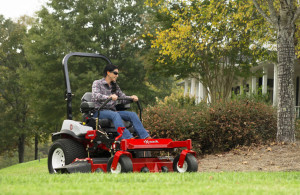When you make the investment in a quality mower, regular maintenance and upkeep is a must. Therefore, it is important to avoid situations that can damage your equipment, cause wear and tear, or even increase your chances of an injury. Take better care of your lawn—and your equipment—by staying away from these common lawn mower mistakes.
Buying More/Less Mower Than You Need: If your yard is smaller in size or covered with many things to mow around, chances are a larger zero-turn mower might not be the right machine for the job. At the same time, a yard that’s half an acre or more could take you hours to trim with a push mower. Always match the lawn mower you use to your specific needs. Considerations like the size of your lawn, the grade of any slopes, the type of terrain and obstacles, like trees, will all play a role.
Low Oil Levels: Just like a car, low oil levels can damage your lawn mower’s engine. To avoid overheating and keep everything lubricated properly, check your mower’s oil level each time you go out.
Low Tire Pressure: If you’re noticing an uneven deck, your problem might be as simple as low tire pressure on one or all of your tires. Low pressure can cause an uneven cut and affect your ability to steer or have proper traction, so always make sure the pressure matches mower guidelines before heading out.
Clogged Decks: The common mower advice to clean out your equipment after every use exists for a reason. Mowers work best and are safest when their blades and undercarriage are clean. After you mow, and once the mower is turned off, remove any dirt, grass, weeds, or other debris, and be sure to give the equipment plenty of time to dry before you put it away.
Dull Blades: Lawn mower blades aren’t meant to last forever. Over time and with excessive use, they will grow dull and less effective overall, which can cause tearing of the grass and make the turf more susceptible to disease. If you aren’t equipped to sharpen mower blades yourself, take them to your authorized dealer for sharpening or replacement.
Not Checking for Rocks and Other Debris: Even fairly small rocks and other debris in the yard can bend or chip your mower blades, leading to dull blades and uneven cutting. More importantly, not removing these items from the lawn before mowing can cause serious injury to others or property damage. Be careful with known rocky areas in your lawn, and trim around rocks that are too big to move before mowing.
Ignoring the Air Filter: When you’re performing regular lawn mower maintenance, make sure you check the air filter. To avoid clogs, wash the filter after each use and replace it once or twice a year.
Cutting a Wet Lawn: Clumps caused by wet clippings can clog the machine, and the water-soaked grass might be more slippery than you think. Even if you’re on a tight mowing schedule, it’s safer to wait until conditions improve.
Bad Storage: A lawn mower isn’t like a car, in that it’s not ideal to leave it parked outside and exposed to the elements. Covered storage is a must when the mower isn’t in use, even if it’s just for a few days at a time; however, you will want to make sure the mower is cooled down before putting it away. You should also consider storage where rodents and other pests can get in.
You should also keep up with mower maintenance schedules and follow the safety instructions for your mower. Most accidents occur because of shortcuts or a failure to properly secure the equipment before you use it. It might take a few extra minutes to get everything running in tip-top shape, but the quality of your lawn and your safety will be well worth it.








